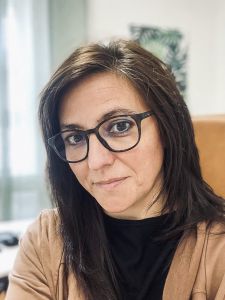
As a trained instrumental teacher, mdw alumna and music school director Johanna Ensbacher is an expert on the cultivation of young talents. In her conversation with mdw Magazine, she revealed the important role played in this by youth orchestras and the challenges faced by Austria’s music schools.
Johanna Ensbacher was influenced quite early by her musical surroundings. Her sister, nineteen years her senior, took violin lessons and motivated the Burgenland native to start taking violin lessons herself at the local music school. Her talent was quickly recognised and nurtured. “I always landed with the right people, for which I’m very grateful. Looking back, I think that the most important thing is to be accompanied on one’s journey—be it by parents, a music school, a university, or mentors. And I’m now in the happy position of being able to do that for young people myself.”
In working at music schools, this experienced educator values the curricular flexibility as well as the one-on-one lessons that enable teachers to address children’s needs individually. The children benefit not only from the improvement of their motor skills but also from the experience of paying heed to each other, as happens in ensemble playing, and of presenting content. “The kids learn so much in their instrumental lessons—like about patience and failure. As well as about how they have to pay attention to themselves in order to practice well. They’re given custom-tailored variants of the appropriate tools by their instrumental teachers.” Today, Johanna Ensbacher devotes herself to the cultivation of young talents as the director of two music schools, the Zentralmusikschule Neusiedl am See and the Joseph Joachim Musikschule Kittsee. “Music schools are there for the broad base, but also for the absolute cream of the crop. We currently have four students who competed in the Federal Competition, and all of them won silver medals. For a music school of our size, that’s a special achievement indeed.”
I want to get the greatest possible number of people excited about music. Music schools should be there for everyone, and it should be made possible for everyone to learn to play an instrument—ideally without any waiting lists!
Just how important getting kids excited about music as early as primary school is when it comes to ensuring a good pool of future musicians is something that this trained elementary music educator knows well. “In elementary music education courses, you have to take a very broad approach—and in that, good and enthusiastic teachers are key. Thereafter, you have to give the kids solid advice on which instruments are most suited to them, let them do lots of trying things out, and point out all the different possibilities.” One of the biggest challenges here is communication between parents, the music school, and the child, as well as the place that the music school has in the children’s leisure activities. “Kids today have very little free time, and making space for lessons at a music school isn’t always easy. What’s more, many kids quit when practicing stops being fun for them.” Belonging to an orchestra or an ensemble can help sustain children’s interest in their instruments, so it’s important that there be suitable offerings for the respective age groups. “I started supporting the Burgenland Youth Symphony Orchestra early on and also took over project management there, because in my day, there hadn’t yet been a dedicated youth orchestra—you had to hold your own amongst the grownups.” The urge to point out suitable opportunities and goals is something that’s motivated this experienced educator ever since. “I can still remember how playing in my music school’s ensemble and then in the Eisenstadt Haydn Orchestra motivated me to learn more. Because there, I learned what you need to be capable of in order to reach your goals.”
As a music school director, it’s important to me to create a framework within which my teachers can work well.
Alongside her educational work, Johanna Ensbacher now serves as concertmistress of the Eisenstadt Haydn Orchestra and the church music ensemble Kirchenmusik Eisenstadt. Conceiving programmes is also among the things she does, as is networking the various orchestras with each other and with the Burgenland Youth Symphony Orchestra. As an experienced violinist, she knows how important one’s own artistic activities are as an educator. “The higher the teacher’s own level on their instrument, the better they’re able to get their students to this level. I think that’s very important, because you’re acting as a role model for the kids.” A further concern of this dedicated educator is encouraging people to stay connected to the region. “Our rural area needs good people who come back and uphold local musical traditions. If everyone stayed in Vienna, nobody would be around to support our rural structures and our young musicians here. So that would be my wish of everyone who’s gone into teaching.” The music school director is all the happier that many of her students remain active in the region today—which she attributes to the personal and long-term contact that a music school makes possible. And for the future, she hopes for more resources and flexibility in personnel matters in order to enable every child and adult to obtain the music school instruction that’s best suited to them. “I want to get the greatest possible number of people excited about music. Music schools should be there for everyone, and it should be made possible for everyone to learn to play an instrument—ideally without any waiting lists!”

